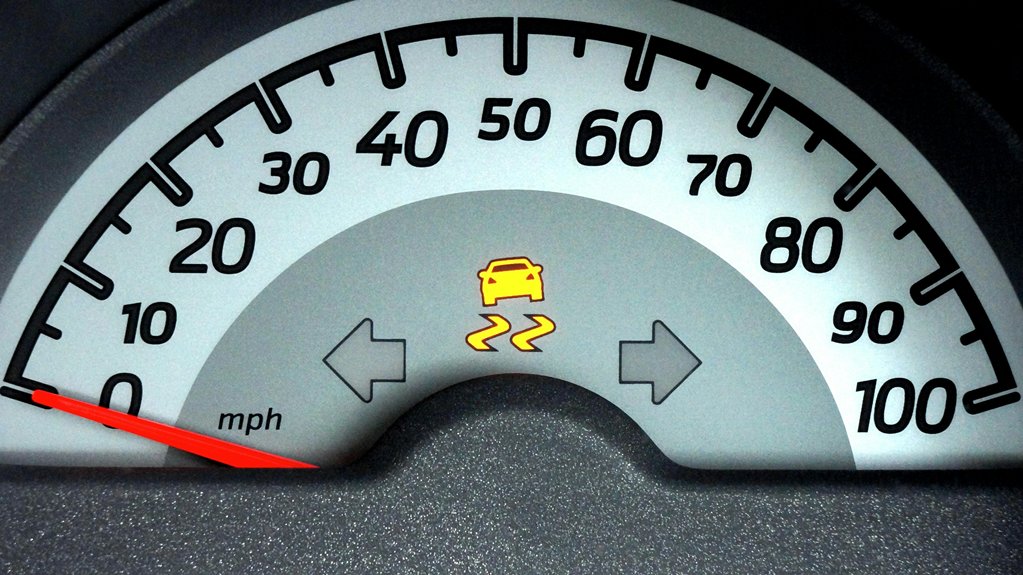When your check engine light comes on, it’s natural to feel a bit concerned, but panicking won’t help. Instead, take a moment to evaluate the situation calmly; sometimes, simple issues like a loose gas cap or minor fluid leaks can trigger the warning. However, there are also more serious problems that require prompt attention. Knowing what steps to take next can prevent further damage and keep you safe—so, here’s how you can handle it effectively.
Stay Calm and Assess the Situation
When your check engine light comes on, it’s important to stay calm and avoid panicking. Often, warning lights can indicate minor issues, like a sensor malfunction, that don’t require immediate repairs. Take a deep breath and assess the situation calmly. Recognize that many transmission-related issues are repairable with trusted auto care services that prioritize honesty and quality. Don’t ignore the light, but also don’t jump to conclusions. Keep track of any other symptoms or unusual noises. Remember, warning lights serve as alerts, not always emergencies. Staying composed helps you focus on the next steps, like checking for obvious issues or scheduling a diagnostic. Remaining tranquil ensures you handle the situation effectively without unnecessary worry.
Check for Obvious Issues and Warning Signs
Before rushing to conclusions, take a quick look under the hood and around your vehicle for obvious issues. Check for warning signs like loose or disconnected hoses, fluid leaks, or unusual smells.
Pay attention to dashboard alerts such as flashing or steady warning lights, which can indicate specific problems.
Notice if the vehicle is making strange noises, smoking, or if the engine feels rough or sluggish. These warning signs can help you identify simple issues that might be causing the check engine light to come on.
Addressing obvious problems early can often prevent more serious damage and save you time and money.
Use an OBD-II Scanner to Read the Error Code
Using an OBD-II scanner is one of the most effective ways to identify the exact cause of your check engine light. It allows you to access sensor diagnostics, revealing which system or sensor may be malfunctioning.
Once connected, the scanner reads the error code stored in your vehicle’s computer, pinpointing the issue. If needed, you can clear the code to reset the light after addressing the problem.
Interpret the Error Code and Determine Urgency
Once you have the error code from your OBD-II scanner, the next step is to interpret what it means. This involves understanding whether it points to sensor diagnosis issues or if warning lights indicate a more serious problem.
Some codes suggest minor sensor malfunctions, which mightn’t need immediate action, while others signal urgent repairs. Check the code’s severity to determine urgency. If the code relates to emissions or engine performance, don’t delay.
Always consult a reliable source or mechanic to understand the implications. Accurately interpreting the code helps you decide whether to seek quick repairs or monitor your vehicle before further diagnosis.
Take Basic Troubleshooting Steps if Possible
When your check engine light comes on, taking some basic troubleshooting steps can help you identify the problem quickly.
First, check fluid levels like oil, coolant, and transmission fluid, as low levels can trigger the warning.
Also, consider a possible sensor malfunction; sometimes, a faulty oxygen or mass airflow sensor causes the light to activate.
Make certain all caps are tight, especially the gas cap, since a loose or damaged cap can also set off the warning.
While these steps won’t fix every issue, they can help you spot simple problems and decide if professional help is needed.
Decide When to Seek Professional Help
After completing basic troubleshooting, recognizing when to seek professional help is the next important step.
If your DIY diagnostics indicate a complex issue or if the check engine light stays on after addressing simple problems, it’s time to consult a mechanic.
Ignoring warning signs can lead to more costly repairs and compromise vehicle maintenance.
Trust your judgment—if you’re unsure about the diagnosis or if the vehicle behaves abnormally, don’t delay seeking expert assistance.
Professional diagnostics can accurately identify underlying problems, ensuring your vehicle runs safely and efficiently.
Knowing when to get professional help keeps your car in top shape and prevents minor issues from becoming major repairs.
Conclusion
When your check engine light comes on, stay calm and follow these steps. Inspect your vehicle for obvious issues, use an OBD-II scanner to identify the problem, and determine if it’s urgent. If you’re unsure or notice abnormal behavior, don’t hesitate to seek professional help. Addressing the warning promptly can prevent further damage and keep you safe on the road. Remember, taking quick action helps keep your vehicle running smoothly. To schedule your free TransScan or to book an appointment, call us today at (919) 471-2506 or visit us online at Durham Transmission.

